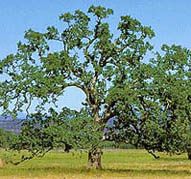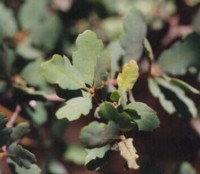

Common Name:
Californis Blue Oak, Iron Oak, Mountain White Oak, Mountain Oak
Genus: Quercus
Species: douglasii

The blue oak is native to the state of California on the western coast of North America. In its natural habitat it grows in the valleys and lower slopes of the Coast Ranges, the lower western foothills of the Sierra Nevada, and the north slope of the San Gabriel Mountains. Blue oak covers about 3 million acres and is one of the largest ancient forest type in California. The Scottish biologist David Douglas first named the blue oak in 1831 for the bluish color of its leaves.
The habitat of blue oaks is open savanna to open woodlands with shrubby understories. At lower elevation it merges with annual grasslands, and at higher elevations it blends with chaparral, pinyon and juniper woodlands. The blue oak often grows among gray pines and other oaks species such as live oak, black oak and valley oak.
Blue oaks are adapted to drought and dry climates. They can survive temperatures above 100° F for several weeks at a time. Average maximum temperatures in July can range from 70° to 100° F. In January minimum temperatures can range from 10° to 35° F. Annual precipitation averages 20 to 40 inches and mostly falls in the form of rain.
The blue oak is a short tree with an open canopy. The canopy is typically rounded with many crooked branches. The tree grows to average heights of 30 feet. In deep, moist soil it can grow up to 60 feet. It is a winter deciduous tree, but will sometimes shed its leaves during severely hot and dry years and go dormant. The litter of leaves and twigs decomposes into a soil high in nutrients and organic matter, holding water better than the surrounding areas. This contributes to high species diversity under the canopies.
Leaves of the blue oak are simple and grow alternately on the twig. The leaves are about 1-3 inches long and have wavy, shallow and irregular margins, usually with 7 lobes. They have a blue-green color above, and yellow-green on the lower surface. A waxy coating covers the tough and thick leaves to help conserve water.
Male flowers are yellow-green catkins. Female flowers are small and often solitary. These grow in the axis of the leaves on new twigs. Blue oaks flower from April through May.

The acorns are long, thin, and gently tapering. They are 3/4 to 1 1/2 inches long with shallow caps. The acorns ripen in one year, and can germinate after one month, unlike other oak varieties, which germinate the following spring. From the beginning most growth is in the roots instead of the shoots. This allows it to tap into available water sources right away, and survive dry conditions. The acorns are palatable to livestock and wildlife. It is an important food source for black-tailed deer, game birds and rodents. At least a dozen species of songbirds also eat the acorns.
The blue oak has an extensive root system. It can grow through cracks in rocks to depths of 80 feet to reach ground water. Its root system allows it to survive in fire prone and arid regions. Blue oaks reproduce both through seeds and vegetatively from burnt or cut stumps. The light colored bark is thick and helps reduce fire damage.
The blue oak isn't used in manufacturing because of its crooked growth habit. But it is used as fence posts and fuel wood. Native Americans made meal from blue oak acorns, and used the acorn leachate for dying baskets. The wood was used to make bowls.
Stands of blue oaks are typically 80 to 100 years old. Blue oaks are slow growers, and small plants can be 25 years old. Some blue oaks are as old as 200 to 500 years old. The number of blue oaks has decreased because there has been no natural regeneration. It is not considered endangered, however, because of its wide distribution across the region.
Bibliography:
Howard, Janet L. "Quercus douglasii", U.S. Department of Agriculture, Forest Service, Rocky Mountain Research Station, Fire Sciences Laboratory (2002, September). Fire Effects Information System, [Online]. Available: http://www.fs.fed.us/database/feis/ [Dec. 2002].
"CNPS - Hardwood Woodlands", http://www.cnps.org/forestry/hardwoods/
"Quercus douglasii fact sheet", http://www.cnr.vt.edu/dendro/dendrology/syllabus/qdouglasii.htm
"Biogeography of Blue Oak", http://bss.sfsu.edu/geog/bholzman/courses/fall99projects/blueoak.htm